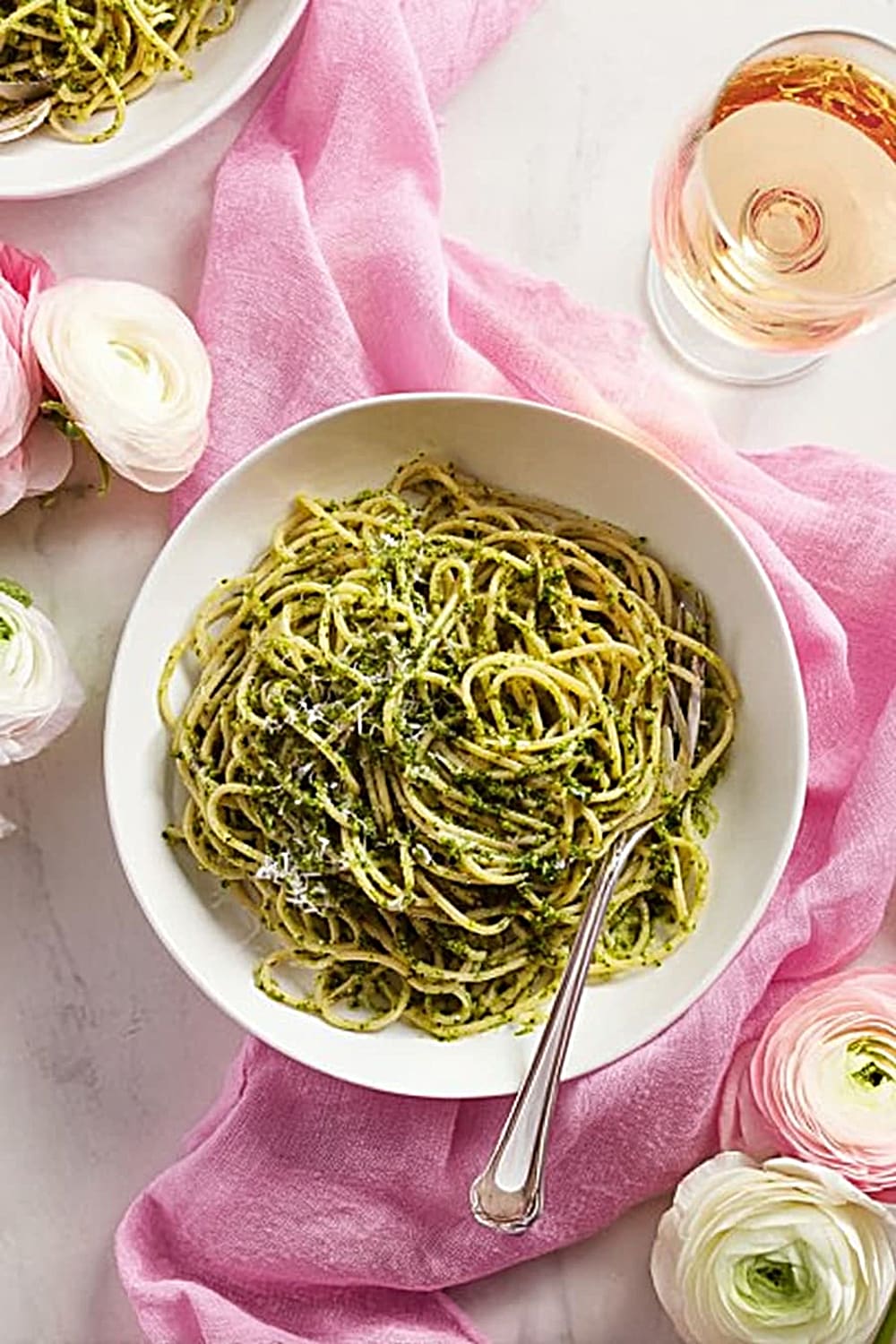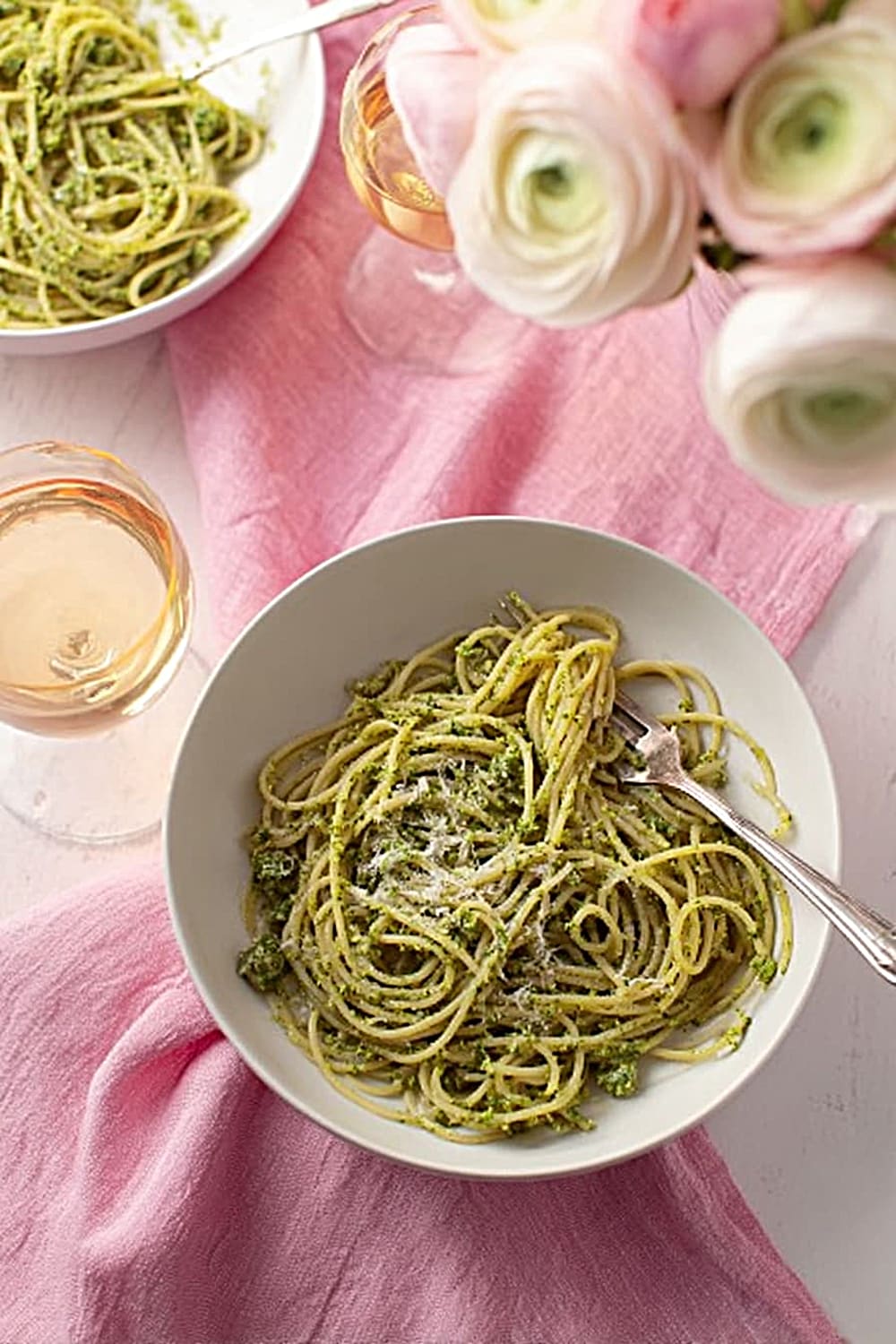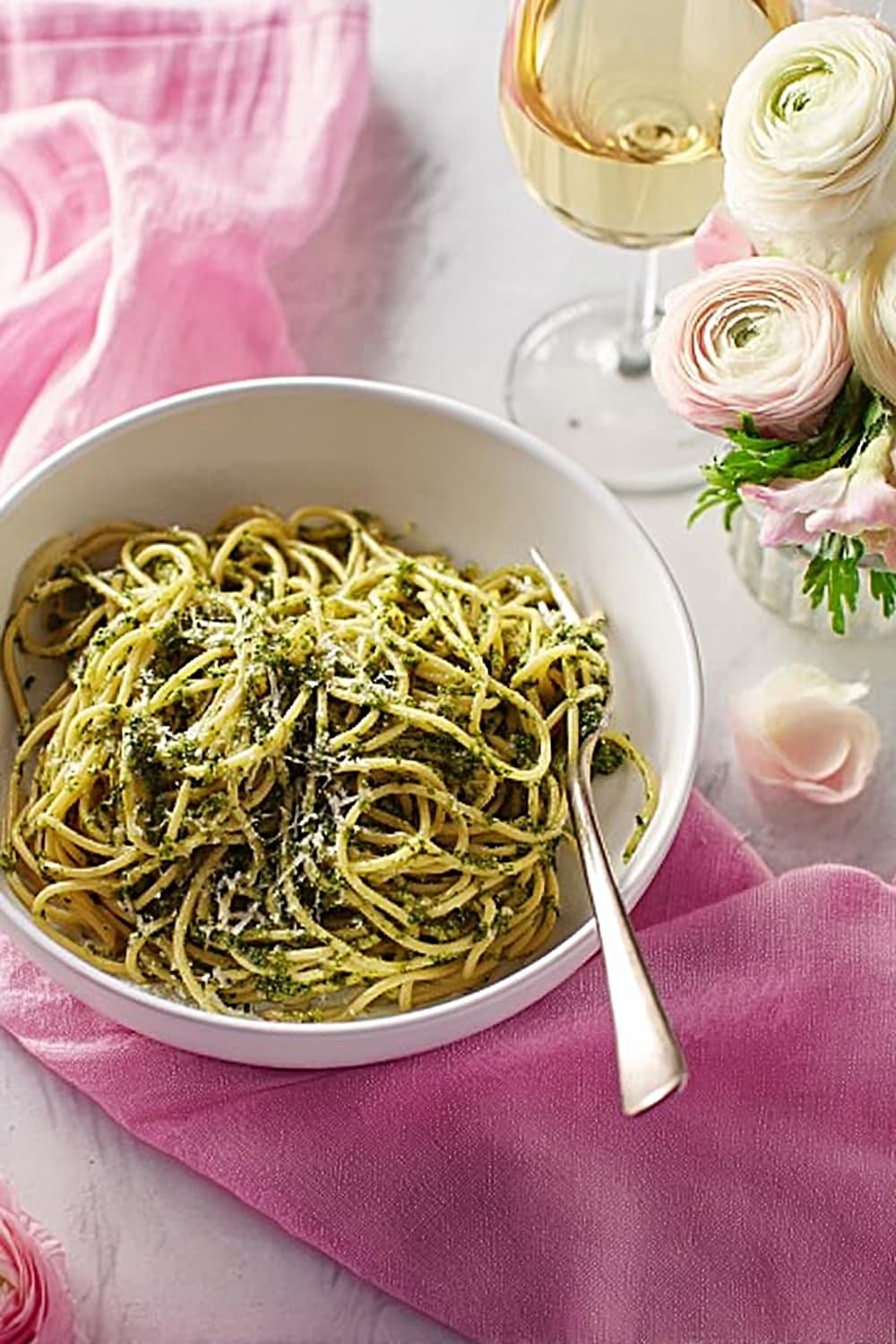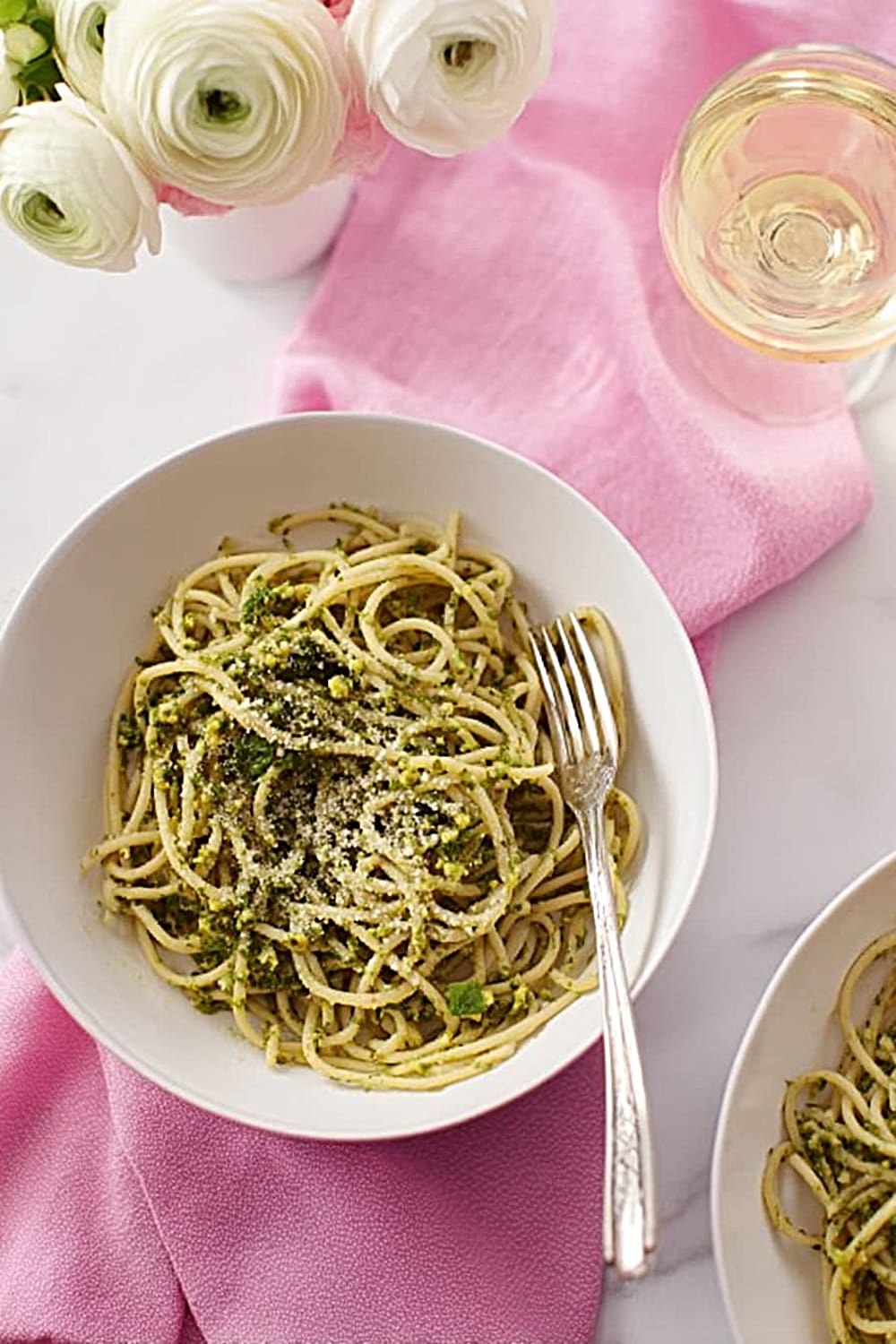Oprah’s Lemon Zest Pasta Recipe

Get ready to transform your weeknight dinner routine with this absolutely stunning pasta that proves sometimes the most magical dishes come from the simplest ingredients!
This isn’t just any pasta recipe – it’s Oprah’s own creation born from one of those “empty pantry” moments we’ve all experienced.
What started as a spontaneous combination of spaghetti and fresh lemons has become a celebration of bright, herbaceous flavors that’ll make your taste buds sing.
The genius lies in how the fresh herb blend creates an aromatic pesto-like coating that clings to every strand of perfectly al dente pasta.

Picture this: tender spaghetti enrobed in a vibrant green herb mixture that’s been elevated with the luxurious touch of truffle salt and finished with a generous shower of fresh lemon zest.
The combination of basil, lemon thyme, and oregano creates layers of flavor that dance on your palate, while the butter spread adds just enough richness to balance the bright acidity of fresh lemon juice.
This recipe delivers restaurant-quality results in just 20 minutes, making it perfect for those nights when you want something special but don’t have hours to spend in the kitchen.
The fresh herbs bring an almost garden-to-table freshness that makes every bite feel like a celebration of simple, quality ingredients.

Ingredients
For the pasta
- 1 pound spaghetti
- Water for boiling
- Salt for pasta water
For the herb mixture
- 1½ cups fresh basil leaves
- 1 teaspoon lemon thyme leaves
- 1 tablespoon fresh oregano leaves
- 2 tablespoons extra virgin olive oil
- 1 tablespoon fresh lemon juice
For finishing
- 2 tablespoons butter spread (like Bestlife Buttery Spread)
- ½ teaspoon truffle salt (or kosher salt)
- ¼ teaspoon ground black pepper
- ¼ cup grated Parmesan cheese
- Zest of 1 lemon

Instructions
Prepare the pasta
- 1 Fill a large pot with water and bring to a rolling boil over high heat. Add 1 tablespoon salt to the water once it reaches a full boil – this seasons the pasta from the inside out and prevents it from tasting bland.
- 2 Add the 1 pound spaghetti to the boiling water and cook according to package directions until al dente, typically 8-10 minutes. Stir occasionally during the first few minutes to prevent sticking, and taste-test starting at 7 minutes to ensure perfect texture.
Create the herb mixture
- 3 While the pasta cooks, combine 1½ cups basil leaves, 1 teaspoon lemon thyme leaves, and 1 tablespoon oregano leaves in your food processor bowl. Make sure all herbs are completely dry – any excess moisture will dilute the vibrant flavors.
- 4 Add 2 tablespoons olive oil and 1 tablespoon fresh lemon juice to the herbs. Pulse the food processor 8-10 times, then process continuously for 30-45 seconds until you achieve a chunky pesto-like consistency. The mixture should be well combined but still have some texture.
Bring it all together
- 5 When the pasta reaches perfect al dente texture, reserve ½ cup pasta cooking water before draining. This starchy water helps bind the sauce to the pasta and creates silky texture.
- 6 Drain the pasta thoroughly and immediately return it to the same pot (off heat). Add the herb mixture and 2 tablespoons butter spread, tossing vigorously with tongs for 1-2 minutes until every strand is beautifully coated.
- 7 Season with ½ teaspoon truffle salt and ¼ teaspoon black pepper, adding 2-3 tablespoons of the reserved pasta water if needed to achieve a glossy, cohesive sauce that clings to each noodle.
Final presentation
- 8 Transfer to serving bowls and immediately garnish with ¼ cup grated Parmesan cheese and the fresh lemon zest. Serve within 2-3 minutes while the pasta is still steaming hot for the best flavor experience.

Recommended Equipment and Kitchen Tools
Essential Tools (for best results):
- Food processor – Creates the perfect herb mixture texture that’s impossible to achieve by hand chopping. A quality food processor ensures even distribution and proper emulsification with the olive oil.
- Large pasta pot – Provides adequate space for pasta to move freely, preventing clumping and ensuring even cooking throughout.
- Fine-mesh strainer – Drains pasta quickly while retaining the perfect amount of moisture for sauce adherence.
- Kitchen tongs – Essential for properly tossing pasta with the herb mixture without breaking delicate strands.
Helpful Upgrades:
- Microplane grater – Creates the finest, most aromatic lemon zest that distributes evenly throughout the dish rather than clumping in large pieces.
- Digital kitchen scale – Ensures precise measurements for consistent results, especially important for the herb ratios.
- Stainless steel mixing bowls – Non-reactive surface preserves the bright flavors of lemon and herbs without any metallic taste.
Nice-to-Have Options:
- Pasta serving bowls – Pre-warmed bowls keep the pasta at optimal serving temperature longer, enhancing the overall dining experience.

Recipe Variations and Dietary Modifications
Gluten-Free Adaptation:
- Replace regular spaghetti with 1 pound gluten-free pasta (rice-based or chickpea varieties work excellently)
- Cook gluten-free pasta 1-2 minutes less than package directions as it can become mushy quickly
- Reserve extra pasta water as gluten-free pasta requires more liquid for proper sauce consistency
Dairy-Free Modifications:
- Substitute butter spread with 2 tablespoons vegan butter or additional olive oil
- Replace Parmesan with ¼ cup nutritional yeast or dairy-free Parmesan alternative
- Add 1 teaspoon extra lemon juice to compensate for the tangy flavor typically provided by cheese
Vegan Version:
- Use plant-based butter substitute and nutritional yeast as mentioned above
- Consider adding 2 tablespoons pine nuts or ¼ cup hemp hearts for richness and protein
- Increase herbs by ½ cup total for more robust flavor without dairy components
Low-Carb Alternative:
- Replace pasta with 2 pounds spiralized zucchini noodles or 1 pound shirataki noodles
- Reduce cooking time to 2-3 minutes for zucchini noodles to maintain texture
- Add ¼ cup extra Parmesan to increase satiety and flavor depth
Flavor Variations:
- Mediterranean twist: Add 2 tablespoons sun-dried tomatoes and 1 tablespoon capers to the herb mixture
- Protein boost: Toss with 1 pound grilled chicken or ½ pound cooked shrimp before serving
- Seasonal adaptation: Replace herbs with whatever’s fresh – try parsley, mint, or chives in different combinations

Nutritional Information and Health Benefits
Key Nutritional Highlights:
This recipe provides approximately 385 calories per serving with a balanced macronutrient profile. Each serving contains roughly 65 grams carbohydrates from the pasta, 8 grams protein from the Parmesan and pasta, and 12 grams healthy fats from olive oil and butter spread. The fresh herbs contribute significant vitamin K, vitamin A, and folate, while providing minimal calories but maximum flavor impact.
Health Benefits of Main Ingredients:
Fresh basil contains powerful antioxidants including eugenol and rosmarinic acid, which have anti-inflammatory properties and may help reduce oxidative stress. The oregano provides carvacrol and thymol, compounds known for their antimicrobial properties and potential immune system support. Lemon juice and zest deliver substantial vitamin C and citrus bioflavonoids that support collagen production and may enhance iron absorption from the pasta. Extra virgin olive oil contributes monounsaturated fats and vitamin E, supporting heart health and providing anti-inflammatory benefits.
Dietary Considerations:
This recipe contains gluten from wheat pasta and dairy from Parmesan cheese. It’s naturally vegetarian and can easily be made vegan with simple substitutions. The dish provides a good source of complex carbohydrates for sustained energy, while the herbs offer concentrated nutrients without added calories. Portion control is key – one serving provides a satisfying meal when paired with a protein source and vegetables.

Smart Swaps and Ingredient Substitutions
Common Substitutions:
- Spaghetti → Angel hair, linguine, or penne (adjust cooking time by 1-2 minutes accordingly)
- Basil leaves → Baby spinach or arugula for different flavor profiles (use same measurements)
- Lemon thyme → Regular thyme plus extra lemon zest (use ½ teaspoon thyme plus 1 teaspoon additional zest)
- Truffle salt → Kosher salt plus ¼ teaspoon truffle oil for similar luxury flavor
Budget-Friendly Swaps:
- Fresh herbs → 2 tablespoons dried Italian seasoning plus ½ cup fresh parsley (much more affordable year-round)
- Truffle salt → Regular kosher salt with 1 teaspoon garlic powder for enhanced flavor complexity
- Parmesan cheese → Romano or Asiago cheese which often cost less but provide similar sharp, salty notes
Pantry Emergency Substitutions:
- Fresh lemon juice → 1 tablespoon white wine vinegar plus ½ teaspoon sugar for similar acidity balance
- Butter spread → 2 tablespoons regular butter or extra olive oil if dairy isn’t available
- Food processor → Finely mince herbs by hand and whisk vigorously with oil and lemon juice
Pro Tips for Substitutions:
- Store leftover fresh herbs in damp paper towels in the refrigerator for up to 5 days
- When using dried herbs, add them directly to the hot pasta to bloom their flavors rather than processing them raw

Make It Diabetes-Friendly
Carb Reduction Strategies:
- Replace half the pasta with spiralized vegetables like zucchini or yellow squash, reducing total carbs by approximately 30 grams per serving
- Use shirataki noodles for the ultimate low-carb version, cutting carbs to under 5 grams per serving
- Choose whole grain or legume-based pasta to increase fiber content and slow glucose absorption
Portion & Timing Tips:
- Reduce serving size to ¾ cup cooked pasta per person instead of full portions
- Add protein like grilled chicken or salmon to slow carbohydrate absorption and increase satiety
- Include fiber-rich vegetables such as sautéed spinach or roasted broccoli to balance the meal
- Estimated carbs per modified serving: 35-40 grams instead of 65 grams
Blood Sugar Management:
- Eat protein first if adding chicken or fish to help moderate glucose response
- Save leftovers properly – reheated pasta has a lower glycemic index than freshly cooked
- Pair with healthy fats like additional olive oil or avocado slices to slow digestion
Total Carb Reduction: Up to 25-30 grams per serving with vegetable substitutions and portion modifications

Perfect Pairing Suggestions
Beverage Pairings:
A crisp Pinot Grigio or Sauvignon Blanc complements the bright lemon and herb flavors beautifully, while their acidity matches the dish’s fresh profile. For red wine lovers, try a light Chianti that won’t overpower the delicate herbs. Non-alcoholic options include sparkling water with fresh lemon or iced green tea with mint, both echoing the recipe’s refreshing qualities. During cooler months, consider herbal tea blends featuring lemon verbena or chamomile.
Side Dish Recommendations:
Grilled asparagus with olive oil and sea salt provides a perfect textural contrast while maintaining the Mediterranean flavor theme. Simple arugula salad with lemon vinaigrette adds peppery notes and fresh crunch. Roasted cherry tomatoes bring sweetness that balances the herbs’ earthiness. For heartier appetites, garlic bread made with herb butter creates a cohesive Italian-inspired meal.
Complete Meal Ideas:
Start with bruschetta topped with fresh tomatoes to continue the fresh herb theme. The pasta pairs excellently with pan-seared salmon or grilled chicken breast as Oprah suggests. Finish with lemon sorbet or fresh berries with whipped cream to maintain the bright, clean flavor progression throughout the meal.
Occasion Suggestions:
Perfect for casual dinner parties, date nights at home, or weekend family dinners when you want something special but achievable. The elegant presentation makes it suitable for spring entertaining or summer patio dining.

Pro Tips and Troubleshooting
Professional Techniques:
Always taste your pasta 1-2 minutes before the package suggests – different brands and altitudes affect cooking times significantly. The key to restaurant-quality results is aggressive tossing with the herb mixture while the pasta is still hot, creating an emulsion that coats every strand. Salt your pasta water until it tastes like mild seawater – this is your only chance to season the pasta itself rather than just the surface.
Common Mistake Prevention:
Never rinse pasta after draining unless making a cold salad – the surface starch helps sauces adhere properly. If your herb mixture seems too thick, add pasta cooking water one tablespoon at a time rather than regular water, which lacks the binding starch. Over-processing herbs creates a paste rather than the desired chunky texture – pulse carefully and check frequently.
Storage and Reheating:
Store leftovers in the refrigerator for up to 3 days in airtight containers. Reheat gently in a skillet with 1-2 tablespoons pasta water or broth to revive the sauce consistency. The dish tastes excellent cold as a pasta salad – add extra lemon juice and a drizzle of olive oil before serving.
Make-Ahead Strategies:
Prepare the herb mixture up to 24 hours ahead and store covered in the refrigerator. Cook pasta just before serving for best texture, but you can have water boiling and ingredients measured for quick assembly.

This remarkable recipe proves that the most memorable dishes often come from the simplest inspirations. Oprah’s genius lies in recognizing that fresh herbs, quality olive oil, and perfectly cooked pasta can create something truly extraordinary when combined with intention and care. Whether you’re cooking for family dinner or entertaining friends, this lemon zest pasta delivers sophisticated flavors that feel both comforting and elegant – exactly what we’ve come to expect from Oprah’s approach to the good life.